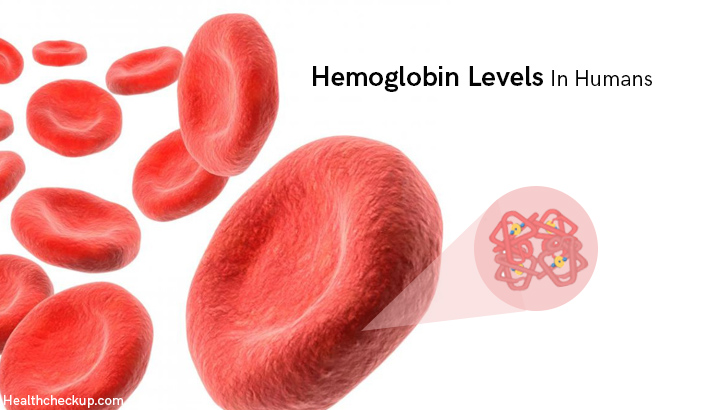Our body is complex machinery composed of various parts and sub parts. All these parts are bound together with a fluid moving all across the body known as blood. This fluid further is composed of various components. One of the most important components of human blood is hemoglobin. Hemoglobin is the red protein in the blood which is responsible for transporting or carrying oxygen within the blood of the human beings and supplying such oxygen to various parts of the body to fulfill their tasks. Just like other health parameters, it is important to understand what is the normal hemoglobin level which the human body needs to maintain?
What Hemoglobin Level is Normal?
Hemoglobin Level is the measurement of the amount of hemoglobin molecule within a specified volume of blood in the human body. The level of hemoglobin, thus, is measured in terms of grams of hemoglobin per deciliter of blood.
The normal range and level of hemoglobin varies according to age and gender of human beings. While the normal range of hemoglobin for men ranges between 13.8 to 17.2 grams per deciliter (g/dL), it ranges around 12.1 to 15.1 g/dL for women.
Hemoglobin Level in Female
The normal levels of hemoglobin in female vary according to age such as
- Females between the age group of 12 to 18 years should have hemoglobin level between 12.0 to 16.0 grams per deciliter of blood. While this is the normal range, the mean of 14.0 grams of hemoglobin per deciliter of blood is the acceptable normal. Any count of hemoglobin below 12.0 g/dL is considered to be low hemoglobin and hemoglobin levels above 16.0 g/dL are considered high hemoglobin levels.
- Females of age above 18 years should have hemoglobin level between 12.1 to 15.1 grams per deciliter of blood. While this is the normal range, the mean of 14.0 grams of hemoglobin per deciliter of blood is the acceptable normal hemoglobin. Any count of hemoglobin below 12.1 g/dL is considered to be low hemoglobin and hemoglobin levels above 15.1 g/dL are considered high hemoglobin levels.
Hemoglobin Level in Male
Just like in females, the normal levels of hemoglobin in males also vary according to age such as
- Males between the age group of 12 to 18 years should have hemoglobin level between 13.0 to 16.0 grams per deciliter of blood. While this is the normal range, the mean of 14.5 grams of hemoglobin per deciliter of blood is the acceptable normal. Any count of hemoglobin below 13.0 g/dL is considered to be low hemoglobin and hemoglobin levels above 16.0 g/dL are considered high hemoglobin levels.
- Males of age above 18 years should have hemoglobin level between 13.6 to 17.7 grams per deciliter of blood. While this is the normal range, the mean of 15.5 grams of hemoglobin per deciliter of blood is the acceptable normal hemoglobin. Any count of hemoglobin below 13.6 g/dL is considered to be low hemoglobin and hemoglobin levels above 17.7 g/dL are considered high hemoglobin levels.
Hemoglobin Level in Child
Normal ranges of hemoglobin levels in children again are determined according to their ages as mentioned below
| Age Group | Normal Range (g/dL) | Normal Mean (g/dL) | High (g/dL) | Low (g/dL) |
| At Birth | 13.5-24.0 | 16.5 | Anything above 24.0 | Anything below 13.5 |
| Below 1 month | 10.0-20.0 | 13.9 | Anything above 20.0 | Anything below 10.0 |
| 1-2 months | 10.0-18.0 | 11.2 | Anything above 18.0 | Anything below 10.0 |
| 2-6 month | 9.5-14.0 | 12.6 | Anything above 14.0 | Anything below 9.5 |
| 6 months to 2 years | 10.5-13.5 | 12.0 | Anything above 13.5 | Anything below 10.5 |
| 2-6 years | 11.5-13.5 | 12.5 | Anything above 13.5 | Anything below 11.5 |
| 6-12 years | 11.5-15.5 | 13.5 | Anything above 15.5 | Anything below 11.5 |
How to Increase Low Hemoglobin Level?
Low levels of hemoglobin in the body are linked to various kinds of problems which would be discussed below. Some of the ways in which hemoglobin levels can be increased include
- Increasing the intake of iron rich foods such as sea food, beans, eggs, spinach, lean meats, and artichokes
- Increasing food rich in cofactors such as vitamin B6, folic acid, vitamin B12, and vitamin C, for e.g., fish, vegetables, nuts, cereals, peas, and citrus fruits
- Consumption of Iron Supplements
- Consumption of minerals such as zinc, copper, and selenium
- Consumption of Beta Carotene supplements
How to Lower Hemoglobin Level?
Just like low levels of hemoglobin, even high levels of hemoglobin in the body are also linked to various kinds of problems which would be discussed below. Some of the ways in which hemoglobin levels can be decreased include:
- Maintaining adequate hydration in the body
- Quitting smoking
- Phlebotomy or bloodletting which would help in reducing blood clots and risk of associated adverse events
How to Check Hemoglobin Levels?
Hemoglobin levels are checked by blood tests. Most often, the complete blood count test is suggested by the physicians. This Complete blood count test not only checks the hemoglobin levels in the blood, but it also provides information about white blood cells (should range between 4,300 and 10,800 cells per cubic millimeter (cmm)), red blood cells (should range between 4.2 to 5.9 million cells per cmm), hematocrit or HCT (should normally range between 45-52 percent for men and 37-48 percent for women), Mean Corpuscular Volume (MCV) (should range between 80 to 100 femtoliters), platelet count, red cell distribution width, and Mean Corpuscular Hemoglobin (MCH) (should range between 27 to 32 picograms).
Apart from the total blood count test, hemoglobin is also checked using the hemoglobin A1c test, especially for diabetes patients, which measures the approximate glucose level occurring in a diabetic person over a three month period by determining the person’s per cent of hemoglobin A1c.
When are Low and High Hemoglobin Levels Critical?
Low Hemoglobin level means that the level of hemoglobin detected in a human body is below the normal range prescribed for the age and sex of the individual. Such low level of hemoglobin levels is also known as anemia.
There are Several Kinds of Anemia Such as
- Iron deficiency anemia (individual does not have enough iron in the body)
- Pregnancy related anemia (iron deficiency leading to low levels of hemoglobin leading to pregnancy related anemia since pregnancy and childbirth requires significant amount of iron)
- Vitamin deficiency anemia (low levels of nutrients which alter the shape of red blood cells making them less effective)
- Aplastic anemia (disorder where blood forming stem cells in the bone marrow are attacked by the immune system resulting in fewer red blood cells)
- Hemolytic anemia (red blood cells are broken up in the bloodstream or the spleen)
- Sickle cell anemia (hemoglobin protein is abnormal which prevents the blood from flowing through small blood vessels)
Some of the popular symptoms of low levels of hemoglobin or anemia include weakness, dizziness, shortness of breath, fast or irregular heartbeat, pale or yellow skin, chest pain, cold hands or feet, headache, and pounding in the ears. In case, these symptoms become critical, it is advised to check with a physician as soon as possible.
Just like low level of hemoglobin levels are risky, even high hemoglobin levels are risky. Some of the common causes of high hemoglobin include:
- Cancer
- Tobacco smoking
- Lung disease such as COPD and emphysema
- Bone marrow disorder such as polycythemia Vera
- Living at high altitude
- Blood doping
- Overdose of drugs such as Epogen, Procrit
Such low and high levels of hemoglobin is a critical factor for people of old age, pregnant women, menstruating women, people with chronic health conditions, and people who do vigorous exercises. In order to prevent such critical condition, it is important to know what hemoglobin level is normal.
Medically Reviewed By

Samarpita is a dedicated freelance writer with avid experience in the space of health, she specializes in topics related to diet, nutrition, immune-related diseases, detection and prevention of diseases and taking a natural route to cure such diseases.








